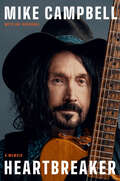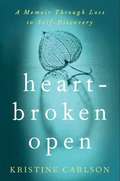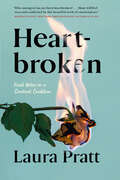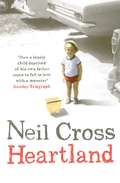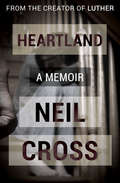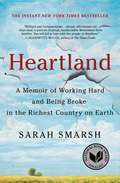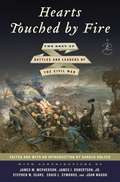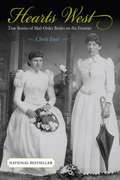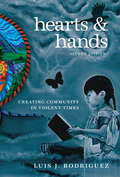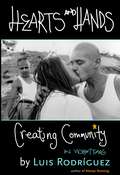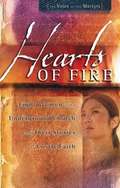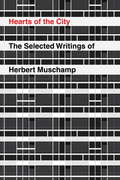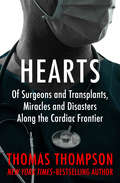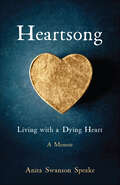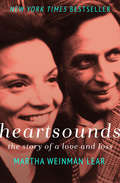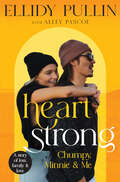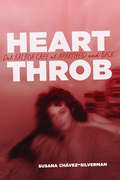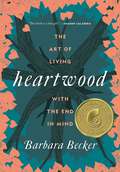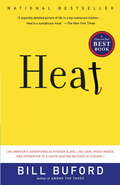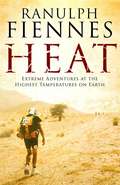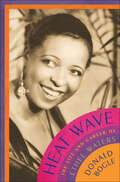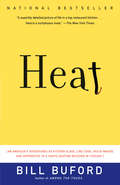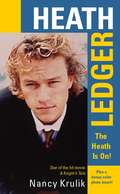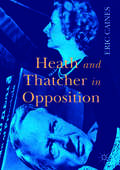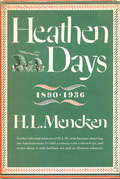- Table View
- List View
Heartbreaker: A Memoir
by Mike CampbellINSTANT NEW YORK TIMES BESTSELLERUSA TODAY BESTSELLER"An exhilarating account. . . . an exemplary music memoir."--Publishers Weekly (starred review) A fast-paced, tender-hearted rock &’n&’ roll memoir for the ages, Mike Campbell&’s Heartbreaker is part rags-to-riches story and part raucous, seat-of-the-pants adventure, recounting Campbell&’s life and times as lead guitarist of Tom Petty and the Heartbreakers. Mike Campbell was the lead guitarist for Tom Petty and the Heartbreakers from the band&’s inception in 1976 to Petty&’s tragic death in 2017. His iconic, melodic playing helped form the foundation of the band&’s sound, as heard on definitive classics like &“American Girl,&” &“Breakdown,&” &“Don&’t Come Around Here No More,&” &“Mary Jane&’s Last Dance,&” &“Learning to Fly&” and &“Into the Great Wide Open.&” Together, Petty and Campbell wrote countless songs, including some of the band&’s biggest hits: &“Refugee,&” &“Here Comes My Girl,&” &“You Got Lucky&” and &“Runnin&’ Down a Dream&” among them. From their early days in Florida to their dizzying rise to superstardom to Petty&’s acclaimed, platinum-selling solo albums Full Moon Fever and Wildflowers, Petty never made a record without him. Their work together is timeless, as are the career-defining hits Campbell co-wrote with Don Henley (&“The Boys of Summer&”) and with Petty for Stevie Nicks (&“Stop Draggin&’ My Heart Around&”). But few know of the less-than-glamorous background from which Campbell emerged—a hardscrabble childhood on the north side of Jacksonville, often just days ahead of homelessness, raised by a single mother struggling on minimum wage. After months of saving, his mother bought him a $15 pawnshop acoustic guitar for his sixteenth birthday. With a chord book and a transistor radio, Campbell painstakingly taught himself to play. When a chance encounter with a guidance counselor inspired him to enroll in the University of Florida, Campbell—broke, with nowhere else to go and the Vietnam draft looming—moved into a rundown farmhouse in Gainesville, where he met a 20-year-old Tom Petty. They were soon inseparable. Together they chased their shared dream all the way to Los Angeles, where Campbell would meet his destiny, and the love of his life, Marcie. It was an at-times grueling dream come true that took Campbell from the very bottom to the absolute top, where Tom Petty and the Heartbreakers would remain for decades, creating an astonishing body of work. Brilliant, soft-spoken and intensely private, Campbell opens up within these pages for the first time, revealing himself to be an astute observer of triumphs, tragedies and absurdities alike, with a songwriter&’s eye for the telling detail and a voice as direct and unpretentious as his music. An instant classic, Heartbreaker is Mike Campbell&’s heartfelt portrait of one throwaway kid&’s lifesaving love of music and the creative heights he achieved through luck, collaboration, humility and extraordinary talent.
Heartbroken Open
by Kristine CarlsonKristine Carlson had an idyllic life. She and her husband, Richard, had a romantic marriage, two beautiful daughters, and-thanks to the success of Richard's bestselling Don't Sweat the Small Stuff series-all the comforts of the American Dream. But on December 13, 2006, that perfect story took a sudden turn when, on a typical flight to New York, a pulmonary embolism would take Richard's life, catapulting Kristine into heartbreak and uncertainty. It was the end of life as Kristine knew it and the beginning of a journey through the depths of grief and mourning that would reveal to Kristine her true strength and an immeasurable love that cannot be broken. This book is a courageously honest memoir. It is the true story of a wife, a mother, a woman forced to come face-to-face with fear, insecurity, and the painful but ultimately precious teachings Kristine Carlson discovered along the way. This wise little book offers a timeless message of inspiration, empowerment, and courage for anyone who has experienced loss or hardship of any kind.
Heartbroken: Field Notes on a Constant Condition
by Laura PrattImbued with longing, erudition and hard-earned wisdom, Heartbroken dares to delve into a universal ordeal—perhaps the one that makes us the most human of all.When Laura Pratt&’s long-distance partner of six years tells her &“it&’s over&” at a busy downtown train station, she is sent reeling, the breakup coming out of the blue. He, meanwhile, closes himself off, refusing to acknowledge Laura and her requests for explanation.In the following days, months and then years, Laura struggles to make sense of this sudden ending, alone and filled with questions. A journalist, she seeks to understand the freefall that is heartbreak and how so many before her survived it, drawing on forces across time and form, and uncovers literary, philosophical, scientific and psychological accounts of the mysterious alchemy of how we human beings fall in love in the first place, and why, when it ends, some of us take longer to get over it, or never do. She weaves this background of cultural history with her own bracing story of passionate love and its loss, and offers some hope for arriving—changed, broadened, grateful—on the other side.
Heartland
by Neil CrossHow a lonely child deprived of his own father came to fall in love with a monster.
Heartland: A Memoir
by Neil CrossFrom the creator of Luther: Told with absolute veracity and unsparing candor, Heartland is the memoir of an isolated little boy and the brutish stepfather he couldn&’t help but love When Neil Cross was born, his mother suffered from severe postpartum depression and later admitted to trying to kill herself and her baby son. Then, when he was five, she &“went out and didn&’t come back,&” leaving behind her children and their heartbroken father. Two years later she returns and gains custody of Neil, taking him to live with her new partner, Derek Cross, who showers him with attention and love in a way that Neil has never known. Derek teaches him about music and books; he is patient but firm, and more reliable than Neil&’s mother. But as Neil grows older he realizes his stepfather is more complicated than he seems. For all his love, Derek is a manipulator, an adulterer, a racist, and a con man. And he is the father whom Neil now loves. With devastating honesty, Neil Cross explores the circumstances of this love—one of pleasant rewards but consequences too dire to predict.
Heartland: A Memoir of Working Hard and Being Broke in the Richest Country on Earth
by Sarah Smarsh*Finalist for the National Book Award* *Finalist for the Kirkus Prize* *Instant New York Times Bestseller* *Named a Best Book of the Year by NPR, New York Post, BuzzFeed, Shelf Awareness, Bustle, and Publishers Weekly* An essential read for our times: an eye-opening memoir of working-class poverty in America that will deepen our understanding of the ways in which class shapes our country and &“a deeply humane memoir that crackles with clarifying insight&”.*Sarah Smarsh was born a fifth generation Kansas wheat farmer on her paternal side, and the product of generations of teen mothers on her maternal side. Through her experiences growing up on a farm thirty miles west of Wichita, we are given a unique and essential look into the lives of poor and working class Americans living in the heartland. During Sarah&’s turbulent childhood in Kansas in the 1980s and 1990s, she enjoyed the freedom of a country childhood, but observed the painful challenges of the poverty around her; untreated medical conditions for lack of insurance or consistent care, unsafe job conditions, abusive relationships, and limited resources and information that would provide for the upward mobility that is the American Dream. By telling the story of her life and the lives of the people she loves with clarity and precision but without judgement, Smarsh challenges us to look more closely at the class divide in our country. Beautifully written, in a distinctive voice, Heartland combines personal narrative with powerful analysis and cultural commentary, challenging the myths about people thought to be less because they earn less. &“Heartland is one of a growing number of important works—including Matthew Desmond&’s Evicted and Amy Goldstein&’s Janesville—that together merit their own section in nonfiction aisles across the country: America&’s postindustrial decline...Smarsh shows how the false promise of the &‘American dream&’ was used to subjugate the poor. It&’s a powerful mantra&” *(The New York Times Book Review).
Hearts Touched by Fire: The Best of Battles and Leaders of the Civil War
by James M. Mcpherson Stephen W. Sears Harold Holzer James I. Robertson Craig L. SymondsIn July 1883, just a few days after the twentieth anniversary of the Battle of Gettysburg, a group of editors at The Century Magazine engaged in a lively argument: Which Civil War battle was the bloodiest battle of them all? One claimed it was Chickamauga, another Cold Harbor. The argument inspired a brainstorm: Why not let the magazine's 125,000 readers in on the conversation by offering "a series of papers on some of the great battles of the war to be written by officers in command on both sides." The articles would be written by generals, Union and Confederate alike, who had commanded the engagements two decades earlier--"or, if he were not living," by "the person most entitled to speak for him or in his place." The pieces would present both sides of each major battle, and would be fair and free of politics. In commemoration of the 150th anniversary of the Civil War, the most enduring entries from the classic four-volume series Battles and Leaders of the Civil War have now been edited and merged into one definitive volume. Here are the best of the immortal first-person accounts of the Civil War originally published in the pages of The Century Magazine more than a hundred years ago. Hearts Touched by Fire offers stunning accounts of the war's great battles written by the men who planned, fought, and witnessed them, from leaders such as General Ulysses S. Grant, General George McClellan, and Confederate captain Clement Sullivane to men of lesser rank. This collection also features new year-by-year introductions by esteemed historians, including James M. McPherson, Craig L. Symonds, and James I. Robertson, Jr., who cast wise modern eyes on the cataclysm that changed America and would go down as the bloodiest conflict in our nation's history. No one interested in our country's past will want to be without this collection of the most popular and influential first-person Civil War memoirs ever published.From the Hardcover edition.
Hearts West: True Stories of Mail-Order Brides on the Frontier
by Chris EnssComplete with actual advertisements from both women seeking husbands and males seeking brides, Hearts West includes twelve stories of courageous mail-order brides and their exploits. Some were fortunate enough to marry good men and live happily ever after; still others found themselves in desperate situations that robbed them of their youth and sometimes their lives. Desperate to strike it rich during the Gold Rush, men sacrificed many creature comforts. Only after they arrived did some of them realize how much they missed female companionship. One way for men living on the frontier to meet women was through subscriptions to heart-and-hand clubs. The men received newspapers with information, and sometimes photographs, about women, with whom they corresponded. Eventually, a man might convince a woman to join him in the West, and in matrimony. Social status, political connections, money, companionship, or security were often considered more than love in these arrangements.
Hearts and Hands, Second Edition
by Luis J. RodriguezHearts and Hands focuses on healing through community building. Empowered by thirty years of experience with gangs in Los Angeles and Chicago, Rodri guez offers a unique book of change. He makes concrete suggestions, shows how we can create nonviolent opportunities for youth today, and redirects kids into productive and satisfying lives. And he warns that we sacrifice community values for material gain when we incarcerate or marginalize people already on the edge of society. His drive to dissolve gang influence on kids is as personal as it is societal; his son, to whom he dedicates Hearts and Hands, served more than a decade in prison for gang-related activity. With anecdotes, interviews, and time-tested guidelines, Hearts and Hands makes a powerful argument for building and supporting community life. From the Trade Paperback edition.
Hearts and Hands: Creating Community in Violent Times
by Luis RodriguezHearts and Hands deals with many of the difficult issues addressed in Luis Rodríguez's memoir of gang life, Always Running, but with a focus on healing through community building. Empowered by his experiences as a peacemaker with gangs in Los Angeles and Chicago, Rodríguez offers a unique book of change. He makes concrete suggestions, shows how we can create nonviolent opportunities for youth today, and redirects kids into productive and satisfying lives. And he warns that we sacrifice community values for material gain when we incarcerate or marginalize people already on the edge of society. His interest in dissolving gang influence on black and latino kids is personal as well as societal; his son, to whom he dedicates Hearts and Hands, is currently serving a prison sentence for gang-related activity. With anecdotes, interviews, and time-tested guidelines, Hearts and Hands makes a powerful argument for building and supporting community life.
Hearts of Fire
by The Voice of the MartyrsStories of persecuted Christian women compiled by the Voice of the Martyrs.
Hearts of the City
by Nicolai Ouroussoff Herbert MuschampFrom the late Herbert Muschamp, the former architecture critic of The New York Times and one of the most outspoken and influential voices in architectural criticism, a collection of his best work.The pieces here--from The New Republic, Artforum, and The New York Times--reveal how Muschamp's views were both ahead of their time and timeless. He often wrote about how the right architecture could be inspiring and uplifting, and he uniquely drew on film, literature, and popular culture to write pieces that were passionate and often personal, changing the landscape of architectural criticism in the process. These columns made architecture a subject accessible to everyone at a moment when, because of the heated debate between modernists and postmodernists, architecture had become part of a larger public dialogue. One of the most courageous and engaged voices in his field, he devoted many columns at the Times to the lack of serious new architecture in this country, and particularly in New York, and spoke out against the agenda of developers. He departed from the usual dry, didactic style of much architectural writing to playfully, for example, compare Frank Gehry's Guggenheim Bilbao to the body of Marilyn Monroe or to wax poetic about a new design for Manhattan's manhole covers. One sees in this collection that Muschamp championed early on the work of Frank Gehry, Rem Koolhaas, Zaha Hadid, Thom Payne, Frank Israel, Jean Nouvel, and Santiago Calatrava, among others, and was drawn to the theoretical writings of such architects as Peter Eisenman. Published here for the first time is the uncut version of his brilliant and poignant essay about gay culture and Edward Durrell Stone's museum at 2 Columbus Circle. Fragments from the book he left unfinished, whose title we took for this collection--"A Dozen Years," "Metroscope," and "Atomic Secrets"--are also included. Hearts of the City is dazzling writing from a humanistic thinker whose work changed forever the way we think about our cities--and the buildings in them.
Hearts: Of Surgeons and Transplants, Miracles and Disasters Along the Cardiac Frontier
by Thomas ThompsonPioneer heart surgeons and bitter rivals: The &“thoroughly engrossing&” true story of doctors Michael DeBakey and Denton Cooley (The New York Times Book Review). By 1970, the Texas Medical Center in Houston was the leading heart institute in the world, home to the field&’s two most distinguished surgeons: Dr. Michael Ellis DeBakey and his young and ambitious disciple, Dr. Denton Arthur Cooley. Their combined mastery in occlusive disease, coronary artery bypass surgery, angioplasty, and heart transplants was unparalleled. For years they worked across the same operating table focused on, and fighting toward, the same lifesaving goals. But what began as a personal friendship and a mutually respectful professional partnership soon deteriorated into a jealous and embittered feud. Though their discord was a cause célèbre among colleagues, it would take award-winning investigative journalist Thomas Thompson to uncover the stunning betrayals and simmering resentments that fueled one of the most famous rivalries in the history of medicine. Weaving the story of DeBakey and Cooley with the stories of patients suffering life-threatening medical conditions, Thompson paints a fascinating portrait of the risks and rewards of cutting-edge science. From devastating tragedies to miraculous breakthroughs, Hearts is a richly detailed and utterly &“compelling&” account of the turmoil and tension behind one of the greatest medical achievements of the twentieth century (Time).
Heartsong: Living with a Dying Heart: A Memoir
by Anita Swanson SpeakeAnita Swanson Speake’s story begins with a diagnosis: idiopathic cardiomyopathy. At sixty-five, she had just found out that her heart was dying. When she got the news, she was in her late sixties. Her girls were raised and gone. Her three decades of high-stress nursing was behind her. She was living with her hopefully last, and certainly best, husband in a big, contemporary house with lots of glass on a lake in rural Northern California. She loved her life. But she didn’t love her scary new medical condition—or the many awful side effects of the medications her doctor promised would serve as a crutch for her heart. As she struggled with all this, Speake began to see herself as a member of the dying rather than the living. And over time, she began to ponder a new question: “Do I really want to get well?” Heartsong takes readers on an often humorous, sometimes sad journey through the best of Western medicine, complemented by a sampling of alternative and Eastern support systems—and through Speake’s evolving relationship with God—as she navigates this transition. Ultimately, with the help of her doctors, a Reiki practitioner, a Mindfulness coach, and her deep, abiding faith, Speake found renewed purpose late in a changing life—and realized God was waiting there for her all along.
Heartsounds: The Story of a Love and Loss
by Martha Weinman LearThe national bestseller and undying testament of a wife&’s love for her husband as he embarks on the fight of his life. On a story assignment in France for the New York Times Magazine, Martha Weinman Lear has just escaped tourist-infested Cannes for a quiet pension in the hills behind the Riviera when she gets the call from New York. Her husband has suffered a massive heart attack and is in the hospital. Harold Lear, a fifty-three-year-old urologist and leader in the field of human sexuality research, suddenly finds himself in the helpless role of the patient. Ripping into the Lears&’ lives and marriage, Hal&’s coronary disease sends them on a journey through New York City&’s medical maze. With bittersweet poignancy, Lear chronicles her husband&’s valiant efforts to combat his sickness as more heart attacks and devastating postsurgical complications befall him. A stunning work of medical drama and journalism, Heartsounds is above all the gripping story of a passionate, enduring love.
Heartstrong
by Ellidy Pullin'If not with you, then for you.'It was a perfect Wednesday morning when Alex 'Chumpy' Pullin kissed his partner, Ellidy, goodbye to go spearfishing. Most days Ellidy would go to the beach too, but that day she didn't. Later, there was a knock at the door. A man had been found unconscious on the ocean floor. It was Chumpy. From that moment, Ellidy's world stopped. There was deep grief, disbelief and then the gradual realisation that this was real. Ellidy's partner of eight years, a World Champion snowboarder, a man of energy and music, was gone. And so was the life they had built together and the dream of the child they had been trying for. In the hours that followed a suggestion was made: did Ellidy want to harvest Chumpy's sperm and try for the baby they both wanted so deeply? There was a ticking clock and the need to discuss with family and friends. They had thirty-six hours before it would be too late . . . Heartstrong is an unforgettable book about love, joy, grief, hope and finding a way to keep going in the darkest of times.
Heartthrob: Del Balboa Cafe al Apartheid and Back
by Susana Chávez-SilvermanHeartthrob: Del Balboa Cafe al Apartheid and Back
Heartwood: The Art of Living with the End in Mind
by Barbara Becker“We can do extraordinary things when we lead with love,” Barbara Becker reminds us in her debut memoir Heartwood.When her earliest childhood friend is diagnosed with a terminal illness, Becker sets off on a quest to immerse herself in what it means to be mortal. Can we live our lives more fully knowing some day we will die?With a keen eye towards that which makes life worth living, interfaith minister, mom and perpetual seeker Barbara Becker recounts stories where life and death intersect in unexpected ways. She volunteers on a hospice floor, becomes an eager student of the many ways people find meaning at the end of life, and accompanies her parents in their final days. Becker inspires readers to live with the end in mind and proves that turning toward loss rather than away from it is the only true way to live life to its fullest. Just as with the heartwood of a tree—the central core that is no longer alive yet supports the newer growth rings—the dead become an enduring source of strength to the living.With life-affirming prose, Becker helps us see that that grief is not a problem to be solved, but rather a sacred invitation—an opportunity to let go into something even greater…a love that will inform all the days of our lives.
Heat
by Bill BufordA highly acclaimed writer and editor, Bill Buford left his job at The New Yorker for a most unlikely destination: the kitchen at Babbo, the revolutionary Italian restaurant created and ruled by superstar chef Mario Batali. Finally realizing a long-held desire to learn first-hand the experience of restaurant cooking, Buford soon finds himself drowning in improperly cubed carrots and scalding pasta water on his quest to learn the tricks of the trade. His love of Italian food then propels him on journeys further afield: to Italy, to discover the secrets of pasta-making and, finally, how to properly slaughter a pig. Throughout, Buford stunningly details the complex aspects of Italian cooking and its long history, creating an engrossing and visceral narrative stuffed with insight and humor.
Heat
by Ranulph FiennesRanulph Fiennes, the world's greatest living explorer, has travelled to some of the most remote, dangerous parts of the globe. Well-known for his experiences at the poles and climbing Everest, he has also endured some of the hottest conditions on the planet, where temperatures regularly exceed 40 degrees and, without water and shelter, death is inevitable.
Heat Wave: The Life and Career of Ethel Waters
by Donald BogleFrom the author of the bestselling Dorothy Dandridge comes a dazzling look at one of America's brightest and most troubled theatrical stars.Almost no other star of the twentieth century reimagined herself with such audacity and durable talent as did Ethel Waters. In this enlightening and engaging biography, Donald Bogle resurrects this astonishing woman from the annals of history, shedding new light on the tumultuous twists and turns of her seven-decade career, which began in Black vaudeville and reached new heights in the steamy nightclubs of 1920s Harlem. Bogle traces Waters' life from her poverty-stricken childhood to her rise in show business; her career as one of the early blues and pop singers, with such hits as "Am I Blue?," "Stormy Weather," and "Heat Wave"; her success as an actress, appearing in such films and plays as The Member of the Wedding and Mamba's Daughters; and through her lonely, painful final years. He illuminates Waters' turbulent private life, including her complicated feelings toward her mother and various lovers; her heated and sometimes well-known feuds with such entertainers as Josephine Baker, Billie Holiday, and Lena Horne; and her tangled relationships with such legends as Irving Berlin, Duke Ellington, Harold Clurman, Elia Kazan, Count Basie, Darryl F. Zanuck, Vincente Minnelli, Fred Zinnemann, Moss Hart, and John Ford.In addition, Bogle explores the ongoing racial battles, growing paranoia, and midlife religious conversion of this bold, brash, wildly talented woman while examining the significance of her highly publicized life to audiences unaccustomed to the travails of a larger-than-life African American woman.Wonderfully atmospheric, richly detailed, and drawn from an array of candid interviews, Heat Wave vividly brings to life a major cultural figure of the twentieth century—a charismatic, complex, and compelling woman, both tragic and triumphant.
Heat: An Amateur Cook in a Professional Kitchen
by Bill BufordHEAT is the story of an amateur cook surviving - or, perhaps more accurately, trying to survive - in a professional kitchen. Until recently, Bill Buford was an enthusiastic, if rather chaotic, home cook. His meals were characterized by two incompatible qualities: their ambition and his inexperience at preparing them. Nevertheless, his lifelong regret was that he'd never worked in a professional kitchen. Then, three years ago, an opportunity presented itself. Buford was asked by the 'New Yorker' to write a profile of Mario Batali, a Falstaffian figure of voracious appetites who ran one of New York's most successful three-star restaurants. Batali had learned his craft by years of training - first, working in London with the young Marco Pierre White; then in California during the Food Revolution; and finally in Italy, being taught how to make pasta by hand in a hillside trattoria. Buford accepted the commission, if Batali would let him work in his kitchen, as his slave. He worked his way up to being a 'line cook' and then left New York to apprentice himself under the very teachers who had taught his teacher: preparing game with Marco Pierre White, making pasta in a hillside trattoria, and finally, in a town in Northern Italy, becoming an Italian butcher. HEAT is a marvellous hybrid: a memoir of Buford's kitchen adventure, the story of Batali's amazing rise to culinary fame, a dazzling behind-the-scenes look at a famous restaurant, and an illuminating exploration of why food matters. It is a book to delight in, and to savour.
Heath Ledger: The Heath Is On!
by Nancy KrulikHEATH WAVE! Heath Ledger may come from the land Down Under, but he's taking Hollywood by storm! After starting out in local musical theater, this talented hottie left his hometown, Perth, and headed to Sydney to forge a career in television and film. Success came easily in Australia, with Heath landing roles in the TV drama Sweat, as well as some Aussie films. Then, at 17 and with less than a dollar in his pocket, the precocious actor decided to try his luck in Los Angeles. He gained instant recognition starring opposite Julia Stiles in 10 Things I Hate About You, but the critical acclaim poured in after he nearly stole the show from Mel Gibson in The Patriot. And the rest has been Hollywood history. With lead roles in the eagerly anticipated films A Knight's Tale and The Four Feathers, Heath's career is on fire! Now, read all about Heath: his family life, his hobbies, his attitude toward show business, and more. In The Heath Is On, you'll get all the info on this up-and-coming young star: gossip, anecdotes, horoscope, vital stats -- it's all in here! The Heath is definitely on!
Heath and Thatcher in Opposition
by Eric CainesThis book traces how Edward Heath and Margaret Thatcher, during their respective years as Conservative Opposition Leaders (1965-70 and 1975-79), managed their Party's attempts to ensure a return to government, each after two electoral defeats. They did so in the context of an emergent New Conservatism, championed by the likes of Enoch Powell, Keith Joseph and Nigel Lawson, which betokened a long-term change from the post-war Butskellite settlement. Against a national background of declining economic status, high inflation, debilitating public sector strikes and internal Conservative Party debates, particularly over industrial relations policy and monetarism, they adopted strikingly different approaches to policy-making in Opposition. The book illustrates how, paradoxically, Heath's technocratic over-prescription failed to save his eventual premiership, while Thatcher's under-committed policy design failed to impede her leading a purposeful and transformative government in the 1980s.
Heathen Days: 1890-1936 (H.L. Mencken's Autobiography)
by H. L. MenckenWith a style that combined biting sarcasm with the "language of the free lunch counter," Henry Louis Mencken shook politics and politicians for nearly half a century. Now, fifty years after Mencken's death, the Johns Hopkins University Press announces The Buncombe Collection, newly packaged editions of nine Mencken classics: Happy Days, Heathen Days, Newspaper Days, Prejudices, Treatise on the Gods, On Politics, Thirty-Five Years of Newspaper Work, Minority Report, and A Second Mencken Chrestomathy. In the third volume of his autobiography, H. L. Mencken covers a range of subjects, from Hoggie Unglebower, the best dog trainer in Christendom, to his visit to the Holy Land, where he looked for the ruins of Gomorrah.
